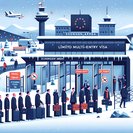
The Czech Statistical Office has confirmed that 6,032,136 tourists stayed at commercial accommodation facilities in Prague between January and September 2025, a two-percent increase year-on-year. German, U.S. and U.K. travellers again made up the largest foreign contingents. Deputy Mayor Jiří Pospíšil stressed that City Hall now wants to ‘spread the load’ by steering visitors beyond the historic core to less-visited districts such as Holešovice and Vinohrady, and by promoting off-season cultural events.
For global-mobility and business-travel managers, the latest statistics confirm that Prague’s hotel market is operating near full capacity in peak periods, with average occupancy above 80 percent and room rates up 6 percent compared with 2024. Corporations planning meetings or extended assignments in the capital will need to reserve accommodation—and, increasingly, co-working space—well in advance.
![Prague tops 6 million international visitors in first nine months of 2025]()
The figures also signal a rebound in long-haul demand. U.S. arrivals grew 9 percent thanks to the resumption of direct New York–Prague flights, while Chinese arrivals, still below 2019 levels, jumped 31 percent after Hainan Airlines restarted Beijing services in the spring. Travel-industry analysts say the Czech Republic’s new Digital-Nomad visa pilot and simplified Schengen short-stay rules for Taiwanese passport-holders have helped diversify source markets.
In the medium term, Prague Airport expects to handle a record 18.4 million passengers in calendar-year 2025, a milestone that will keep pressure on public-transport links between Václav Havel Airport and the city centre. Construction of the long-planned rail spur is not due to begin until 2026, so the airport authority is adding more express-bus departures and lobbying rideshare operators to guarantee multilingual drivers.
For global-mobility and business-travel managers, the latest statistics confirm that Prague’s hotel market is operating near full capacity in peak periods, with average occupancy above 80 percent and room rates up 6 percent compared with 2024. Corporations planning meetings or extended assignments in the capital will need to reserve accommodation—and, increasingly, co-working space—well in advance.

The figures also signal a rebound in long-haul demand. U.S. arrivals grew 9 percent thanks to the resumption of direct New York–Prague flights, while Chinese arrivals, still below 2019 levels, jumped 31 percent after Hainan Airlines restarted Beijing services in the spring. Travel-industry analysts say the Czech Republic’s new Digital-Nomad visa pilot and simplified Schengen short-stay rules for Taiwanese passport-holders have helped diversify source markets.
In the medium term, Prague Airport expects to handle a record 18.4 million passengers in calendar-year 2025, a milestone that will keep pressure on public-transport links between Václav Havel Airport and the city centre. Construction of the long-planned rail spur is not due to begin until 2026, so the airport authority is adding more express-bus departures and lobbying rideshare operators to guarantee multilingual drivers.






